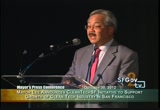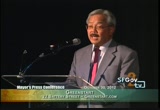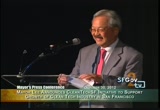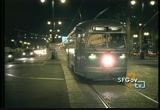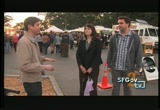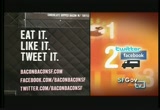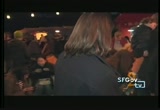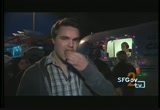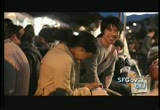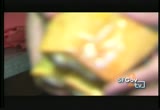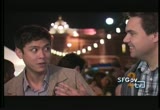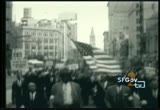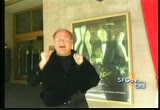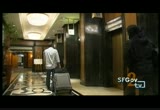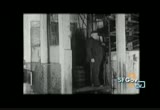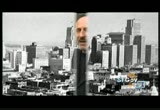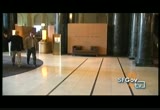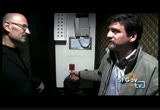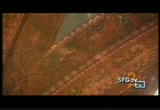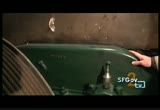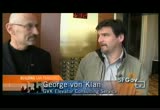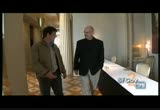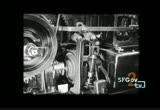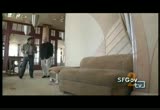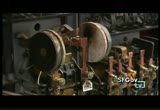tv [untitled] October 31, 2012 1:00pm-1:30pm PDT
1:05 pm
1:06 pm
or something unique like curry. we areher here in the average eight -- upper haight. you will be competing in the quick buy food challenge. an appetizer and if you are the winner you will get the title of the quitck bite "chompion." i am here with matt cohen, from off the grid. >> we assembled trucks and put them into a really unique heurban settings.
1:07 pm
>> what inspired you to start off the grid? >> i was helping people lodge mobile food trucks. the work asking for what can we get -- part together? we started our first location and then from there we expanded locations. >> why do think food trucks have grown? >> i have gotten popular because the high cost of starting a brick and mortar or strong, the rise of social media, trucks can be easily located, and food trucks to offer a unique outdoor experience that is not easily replaced by any of their setting any worlwhere else in san franc. san francisco eaters are interested in cuisine. there adventuress.
1:08 pm
the fact theyuse grea use great ingredients and make gourmet food makes unpopular. >> i have been dying to have these. >> i have had that roach coach experience. it is great they're making food they can trust. >> have you decided? >> we are in the thick of the competition? >> my game was thrown off because they pulled out of my first appetizer choice. >> how we going to crush clear? >> it will be easy. probably everyone has tried, something bacon tell us
1:09 pm
delicious. >> -- people tell us is delicious. >> hopefully you think the same thing. >> hopefully i am going to win. we're in the financial district. there is a food truck right there. every day changes. it is easy and fun to go down. these are going to be really good. >> how are you going to dominate? >> i think he does not know what he is doing. >> i was thinking of doing [unintelligible] we are underrepresented. >> i was singing of starting an irish pub. that was my idea. >> one our biggest is the corned beef and cabbage. we are asking people what
1:10 pm
they're thinking in getting some feedback. >> for a lot of people i am sure this combination looks very wrong. it might not sound right on paper but when you taste it to or have it in your mouth, it is a variety. this is one of the best ways in creating community. people gather around and talk about it and get to know different cultures. that brings people together and i hope more off the grid style and people can mingle and interact and remove all our differences and work on our similarities. this creates opportunity. >> the time has come and i am very hungry. what have you got? >> i got this from on the go, a sandwich, and a caramel
1:11 pm
cupcake. i went with home cooking. what de think? >> i will have another bite. >> sounds good. >> that was fantastic. let's start with you. >> i had the fried mac and cheese, and twinkies. i wanted to get something kind of classic with a twist on it. >> it was crispy. >> i will admit. >> want to try fieried mac and cheese? >> was that the best twinkie? >> would you say you had the
1:12 pm
1:16 pm
>> welcome. we are here doing our building san francisco tour. we're going to have a very interesting tour of elevators in sanford cisco. we have all gotten into an elevator, the doors have closed, and it has carried us to our destination. have you ever wondered how elevators were -- work? we check out the need outside the elevator using current technology and we learn about the latest destination elevated technology all here in san francisco.
1:17 pm
we will also visit the machinery where all the behind- the-scenes gears control these incredible machines. we are very fortunate today to have an expert with those who is going to walk us are around elevators in san francisco. can you tell us about the history of elevators in san francisco? the measure -- >> sure. the history of elevator technology evolves with the city. first elevators were installed for moving materials in the 1860's. in the 1870's, the first passenger elevator was installed, and that allowed building heights to go up to about seven floors. starting in the 18 eighties, 1890's, the first electric elevators were installed. that allowed for buildings to go up even higher, even more than 10 floors, and those were the first elevators that became representative of what we consider modern elevators today.
1:18 pm
>> so the height of buildings is related to elevator technology. >> both of these technologies encourage architects to build taller buildings. engineering and materials science provided a higher quality of steel to build with, and having passenger elevators meant it was the necessary anymore to climb a long flight of stairs to get to the top of the building. the elevator made the upper floors of the building more attractive than they were before. >> here we were at the historic st. francis hotel, which was actually a representation of the evolution of elevators. can you tell us more about san francisco history here at the st. francis? >> sure. st. francis demonstrates well the evolution of elevated technology. and substantially damaged the 1906 earthquake and rebuilt in
1:19 pm
1907 or 1908, and extend it again in 1913. then a new tower was added in 1932, so there is all sorts of elevator technology you can see at the st. francis that very much represents the building history of san francisco. >> i understand there is a really old elevator still operating here. >> that is right, the elevator installed in the 1913 expansion. we can go look at that. >> let's go take a look. here we are in a spectacular st. francis lobby. here is the clock. when people say "meet me at the clock in the st. francis." let's look at that elevator. >> ok, let's do it.
1:20 pm
>> here we are in the elevator installed as part of the expansion, and this is the way it was originally installed about 100 years ago. it has a manual switch just like elevators did back then, and it runs on dc power. this was from a time before elevators ran on ac power. >> when did they switch? >> decided to switch in the 1920's, so this elevator predicts that by about 19 years. the doors are also manual, so this elevator predates the use of automatic doors on elevators. >> can we take a ride? >> absolutely. going down. >> how many troops do you think this elevator has taken in its
1:21 pm
lifetime? millions. >> yes, this one probably has. certainly hundreds of thousands. >> very smooth. >> it really does run smoothly. >> there we go. take some serious operation. there we go. >> this is really beautiful. >> this is served by that old elevator we were just in. >> built at the same time, also in 1913. >> what a gorgeous room. i think we should have a party here. >> that is a great idea. >> let's look at the machine room for that old elevator. >> ok, let's go. >> here we are in the machine room with all these wonderful, old, a burly, industrial-era equipment. tell us what we've got here. >> this is really the beginning of a modern elevator. what we would describe as an overhead traction-geared
1:22 pm
elevator. that type of elevator still exists. even though this was made in 1913, elevators like this have continued to be manufactured up until the present day. >> so overhead means these cables attached to the top of the car. >> correct, exactly right. >> our hoist machine is located overhead, and this is a traction machine, so it is an evolution beyond the winding from elevator. this is the drive ship. this is the gear box, and this is original from 1913. it is a heavy-duty design that we really do not see any more today. that is probably part of the reason why this elevator has already lasted close to 100 years. this is the break for the voice machine -- teh brake. >> we have the original controller here. fortunately, the power is turned off. >> this room was built in 1913, but the national elevator cut actually was not introduced
1:23 pm
until 1921. >> tell us about this antique controller. what makes it different from a modern controller? >> the elevator is running on the original d.c. power. really simple in operation. does not include a lot of the features we would have in an elevator today, automatic door operation, dispatching, push button operation. none of those features are present, but this is the original from 1913. on this side, we have all the relays that actually control the elevator. the safety service -- city circuit, position, speed, and control of the power to the motor. >> here is a really interesting piece of historic machinery. tell us about this. >> this is one of the main safety devices of the elevator system, and the device still exists today even on modern
1:24 pm
elevators. it detects if the elevator is going into unsafe over speed conditions. it is attached to the road itself, and the car over speeds, bees fly balls would come out, and the governor jobs would come out and grab on to the governor wrote, which would hold the break or the safety on the elevator to cause it to stop. >> if you have problems, i see right here, we call garfield 7171 for service. member that is right. operators standing by. >> from here, we are going to look at those wonderful elevators that go of the outside of the high rise building that everyone wants to take a ride in. >> let's go do that. >> here we are in the most exciting elevator in the city of san francisco. this is the outside elevator that goes into the 32nd floor. tell us about this. >> we are in one of the tower
1:25 pm
elevators now. these were originally installed in 1972. 1,000 feet a minute, outside observation elevators, so a great view of the city. some of the most popular elevators in san francisco, as you mentioned, and these cars run a lot. they run about 2000 starts per day. about 700,000 starts per year for an elevator like this, and these are pretty hard working. >> must be hard to maintain these elevators. mechanical devices in the rain. >> this is much more difficult to maintain. normal elevator installation is all sealed from the elements, but in this case, it is all exposed to the outside, so there are issues with whether proofing and sealing the equipment from the elements. >> the controls and motors are up here on the top floor. >> very simple -- similar to the elevators we looked at. this is similar to that technology. >> i saw a crowd of people downstairs waiting to take a ride on the elevated to get this
1:26 pm
fabulous view. that is a terrific view. >> yes, it is great. >> can you tell us about the history of the modern elevators? >> what we consider the modern elevator is the elevator with a safety device that was built in new york in 1853 in response to a freight elevator accident in new york city. until that time, elevators were quite common in buildings but typically used just for handling freight. elisha otis -- elijah otis successfully demonstrated the safety device he had created. even of the elevator and he cut the device, and he did not fall.
1:27 pm
everyone was impressed by that. in 1857, the oldest brother's company installed their first passenger elevator on broadway in new york. believe it or not, many of those first elevators were actually started and stopped by a hand broke. >> what drove those old elevators? what was their motive power? >> in some cases, they might have even been hp. >> and then changed to electric? >> electric cited to come in the 1890's, and that was around the time when the elevator stopped from material handling and started to be used more frequently for passengers. in 1878, there was a demonstration of the other thing that allowed architects to build taller buildings was the advent of a higher quality steel manufacturing. in 19003, the first production
1:28 pm
year track models were introduced, that it was when things took off. >> that mostly happened in new york city? >> lower manhattan was the first place that took off, then chicago. those early passenger elevators always had an attendant that would take a passenger's request and then operate the car. the big change was the emergence of a electric elevators. starting in 1880, the electric elevator allowed building dollars to go much higher. we evolved from steam hydraulic elevators to the electric elevators that are not that much different from what we are going to see now at the top of the tower. this is the steam room on the top of the state st. francis. -- on top of the state francis.
1:29 pm
the equipment you see painted green, that is all the original equipment from 1972. we are just now in the middle of modernizing this equipment. >> why modernize? doesn't the equipment works fine? >> it does, it is of analog and intensive, and there are some additional controls. let me introduce the foreman to you. this is vince. he can do a better job explaining the project details. >> what is happening here, what are you doing? >> we are doing a major modernization. we are tearing out the old system, logic controls, and generator contro
80 Views
IN COLLECTIONS
SFGTV2: San Francisco Government Television Television Archive
Television Archive  Television Archive News Search Service
Television Archive News Search Service 
Uploaded by TV Archive on

 Live Music Archive
Live Music Archive Librivox Free Audio
Librivox Free Audio Metropolitan Museum
Metropolitan Museum Cleveland Museum of Art
Cleveland Museum of Art Internet Arcade
Internet Arcade Console Living Room
Console Living Room Books to Borrow
Books to Borrow Open Library
Open Library TV News
TV News Understanding 9/11
Understanding 9/11